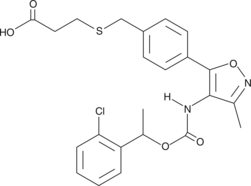Chemicals
Showing 24001–24150 of 41137 results
-
Kevetrin is an activator of p53.{47554,47555} It increases levels of activated p53 and expression of p21 in A549 cells and decreases expression of the transcription factor E2F1 in a variety of cell lines.{47554,47555} Kevetrin decreases cell viability in a panel of cancer cell lines with a mean IC50 value of 0.49 μM.{47556} It reduces tumor growth in MDA-MB-231, HT-29, PC3, HCT15, A549, NCI-H1975, CRL-1619, LNCaP, MIA PaCa, and SCC-5 mouse xenograft models when administered at a dose of 200 mg/kg.
Brand:CaymanSKU:28288 - 50 mgAvailable on backorder
Soluble adenylyl cyclase mediates bicarbonate-stimulated production of the ubiquitous second messenger adenosine 3’,5’-cyclic mononucleotide (cAMP).{17154} It is abundantly expressed in sperm, in fluid transporting tissues such as kidney cortex and medulla, and in other bicarbonate-responsive tissues and cells. KH7 is a selective inhibitor of soluble adenylyl cyclase (sAC) that has little effect on transmembrane adenylyl cyclases.{17005} It displays an IC50 value between 3-10 µM toward sAC.{17005} At 50 µM, KH7 decreases basal cAMP accumulation in sperm.{17005} KH7 has been used in diverse research applications including cAMP-mediated signaling events required for mammalian egg fertilization,{17005} sAC regulation of Na+ transport in the kidney,{17006} and mitochondrial-dependent apoptosis in response to various stress stimuli.{17155} KH7 is not active against sAC in the presence of detergents. At concentrations above 50 µM, KH7 exhibits non-specific membrane disruption effects when used on cells.
Brand:CaymanSKU:-Soluble adenylyl cyclase mediates bicarbonate-stimulated production of the ubiquitous second messenger adenosine 3’,5’-cyclic mononucleotide (cAMP).{17154} It is abundantly expressed in sperm, in fluid transporting tissues such as kidney cortex and medulla, and in other bicarbonate-responsive tissues and cells. KH7 is a selective inhibitor of soluble adenylyl cyclase (sAC) that has little effect on transmembrane adenylyl cyclases.{17005} It displays an IC50 value between 3-10 µM toward sAC.{17005} At 50 µM, KH7 decreases basal cAMP accumulation in sperm.{17005} KH7 has been used in diverse research applications including cAMP-mediated signaling events required for mammalian egg fertilization,{17005} sAC regulation of Na+ transport in the kidney,{17006} and mitochondrial-dependent apoptosis in response to various stress stimuli.{17155} KH7 is not active against sAC in the presence of detergents. At concentrations above 50 µM, KH7 exhibits non-specific membrane disruption effects when used on cells.
Brand:CaymanSKU:-Soluble adenylyl cyclase mediates bicarbonate-stimulated production of the ubiquitous second messenger adenosine 3’,5’-cyclic mononucleotide (cAMP).{17154} It is abundantly expressed in sperm, in fluid transporting tissues such as kidney cortex and medulla, and in other bicarbonate-responsive tissues and cells. KH7 is a selective inhibitor of soluble adenylyl cyclase (sAC) that has little effect on transmembrane adenylyl cyclases.{17005} It displays an IC50 value between 3-10 µM toward sAC.{17005} At 50 µM, KH7 decreases basal cAMP accumulation in sperm.{17005} KH7 has been used in diverse research applications including cAMP-mediated signaling events required for mammalian egg fertilization,{17005} sAC regulation of Na+ transport in the kidney,{17006} and mitochondrial-dependent apoptosis in response to various stress stimuli.{17155} KH7 is not active against sAC in the presence of detergents. At concentrations above 50 µM, KH7 exhibits non-specific membrane disruption effects when used on cells.
Brand:CaymanSKU:-Soluble adenylyl cyclase mediates bicarbonate-stimulated production of the ubiquitous second messenger adenosine 3’,5’-cyclic mononucleotide (cAMP).{17154} It is abundantly expressed in sperm, in fluid transporting tissues such as kidney cortex and medulla, and in other bicarbonate-responsive tissues and cells. KH7 is a selective inhibitor of soluble adenylyl cyclase (sAC) that has little effect on transmembrane adenylyl cyclases.{17005} It displays an IC50 value between 3-10 µM toward sAC.{17005} At 50 µM, KH7 decreases basal cAMP accumulation in sperm.{17005} KH7 has been used in diverse research applications including cAMP-mediated signaling events required for mammalian egg fertilization,{17005} sAC regulation of Na+ transport in the kidney,{17006} and mitochondrial-dependent apoptosis in response to various stress stimuli.{17155} KH7 is not active against sAC in the presence of detergents. At concentrations above 50 µM, KH7 exhibits non-specific membrane disruption effects when used on cells.
Brand:CaymanSKU:-Lysophosphatidic acid (LPA) is a bioactive lipid mediator that signals through five distinct G protein-coupled receptors (LPA1-5).{16449} Ki16425 is a LPA receptor antagonist with selectivity for LPA1 and LPA3. It exhibits Ki values of 0.34, 6.5, and 0.93 µM for the human LPA1, LPA2, and LPA3 receptors, respectively, as determined by measuring inositol phosphate production in RH7777-transfected cells.{11515} Ki1642, at 10 µM, significantly blocks the response of a variety of cancer cell lines to LPA-induced cell migration.{16453}
Brand:CaymanSKU:10012659 - 1 mgAvailable on backorder
Lysophosphatidic acid (LPA) is a bioactive lipid mediator that signals through five distinct G protein-coupled receptors (LPA1-5).{16449} Ki16425 is a LPA receptor antagonist with selectivity for LPA1 and LPA3. It exhibits Ki values of 0.34, 6.5, and 0.93 µM for the human LPA1, LPA2, and LPA3 receptors, respectively, as determined by measuring inositol phosphate production in RH7777-transfected cells.{11515} Ki1642, at 10 µM, significantly blocks the response of a variety of cancer cell lines to LPA-induced cell migration.{16453}
Brand:CaymanSKU:10012659 - 10 mgAvailable on backorder
Lysophosphatidic acid (LPA) is a bioactive lipid mediator that signals through five distinct G protein-coupled receptors (LPA1-5).{16449} Ki16425 is a LPA receptor antagonist with selectivity for LPA1 and LPA3. It exhibits Ki values of 0.34, 6.5, and 0.93 µM for the human LPA1, LPA2, and LPA3 receptors, respectively, as determined by measuring inositol phosphate production in RH7777-transfected cells.{11515} Ki1642, at 10 µM, significantly blocks the response of a variety of cancer cell lines to LPA-induced cell migration.{16453}
Brand:CaymanSKU:10012659 - 100 mgAvailable on backorder
Lysophosphatidic acid (LPA) is a bioactive lipid mediator that signals through five distinct G protein-coupled receptors (LPA1-5).{16449} Ki16425 is a LPA receptor antagonist with selectivity for LPA1 and LPA3. It exhibits Ki values of 0.34, 6.5, and 0.93 µM for the human LPA1, LPA2, and LPA3 receptors, respectively, as determined by measuring inositol phosphate production in RH7777-transfected cells.{11515} Ki1642, at 10 µM, significantly blocks the response of a variety of cancer cell lines to LPA-induced cell migration.{16453}
Brand:CaymanSKU:10012659 - 5 mgAvailable on backorder
Ki20227 is an inhibitor of macrophage colony stimulating factor 1 (CSF1) receptor tyrosine kinase (c-Fms; IC50 = 2 nM).{40050} It inhibits CSF1-dependent c-Fms phosphorylation in a dose-dependent manner in RAW264.7 cells and reduces CSF1-dependent growth of M-NFS-60 cells (IC50 = 14 nM). Ki20227 suppresses development of TRAP-positive osteoclast-like cells from murine bone marrow (IC50 = 40 nM) and decreases the number and area of osteolytic lesions on femurs and tibiae in a murine A375 subcutaneous xenograft model. Ki20227 also reduces TNF-α infiltration and osteolytic bone destruction in a collagen-induced arthritis (CIA) mouse model.{40051}
Brand:CaymanSKU:22258 -Out of stock
Ki20227 is an inhibitor of macrophage colony stimulating factor 1 (CSF1) receptor tyrosine kinase (c-Fms; IC50 = 2 nM).{40050} It inhibits CSF1-dependent c-Fms phosphorylation in a dose-dependent manner in RAW264.7 cells and reduces CSF1-dependent growth of M-NFS-60 cells (IC50 = 14 nM). Ki20227 suppresses development of TRAP-positive osteoclast-like cells from murine bone marrow (IC50 = 40 nM) and decreases the number and area of osteolytic lesions on femurs and tibiae in a murine A375 subcutaneous xenograft model. Ki20227 also reduces TNF-α infiltration and osteolytic bone destruction in a collagen-induced arthritis (CIA) mouse model.{40051}
Brand:CaymanSKU:22258 -Out of stock
Ki20227 is an inhibitor of macrophage colony stimulating factor 1 (CSF1) receptor tyrosine kinase (c-Fms; IC50 = 2 nM).{40050} It inhibits CSF1-dependent c-Fms phosphorylation in a dose-dependent manner in RAW264.7 cells and reduces CSF1-dependent growth of M-NFS-60 cells (IC50 = 14 nM). Ki20227 suppresses development of TRAP-positive osteoclast-like cells from murine bone marrow (IC50 = 40 nM) and decreases the number and area of osteolytic lesions on femurs and tibiae in a murine A375 subcutaneous xenograft model. Ki20227 also reduces TNF-α infiltration and osteolytic bone destruction in a collagen-induced arthritis (CIA) mouse model.{40051}
Brand:CaymanSKU:22258 -Out of stock
Ki20227 is an inhibitor of macrophage colony stimulating factor 1 (CSF1) receptor tyrosine kinase (c-Fms; IC50 = 2 nM).{40050} It inhibits CSF1-dependent c-Fms phosphorylation in a dose-dependent manner in RAW264.7 cells and reduces CSF1-dependent growth of M-NFS-60 cells (IC50 = 14 nM). Ki20227 suppresses development of TRAP-positive osteoclast-like cells from murine bone marrow (IC50 = 40 nM) and decreases the number and area of osteolytic lesions on femurs and tibiae in a murine A375 subcutaneous xenograft model. Ki20227 also reduces TNF-α infiltration and osteolytic bone destruction in a collagen-induced arthritis (CIA) mouse model.{40051}
Brand:CaymanSKU:22258 -Out of stock
Vascular endothelial growth factor receptor 2 (VEGFR2, also known as KDR and FLK1) is a receptor tyrosine kinase that regulates angiogenesis, vascular development, and embryonic hematopoiesis in response to VEGF isoforms A, C, and D. Ki8751 is a potent, orally available inhibitor of the kinase activity of VEGFR2 (IC50 = 0.9 nM).{31021} It less potently inhibits c-Kit, PDGRFα, and FGFR2 (IC50s = 40-170 nM) and has no significant effect against several other receptor tyrosine kinases. Ki8751 suppresses the growth of VEGF-stimulated human umbilical vein endothelial cells at nanomolar concentrations.{31021} It shows significant anti-tumor activity against assorted human tumor xenografts in nude mice.{31021} Ki8751 also induces cellular senescence in colorectal cancer cells.{31020}
Brand:CaymanSKU:-Available on backorder
Vascular endothelial growth factor receptor 2 (VEGFR2, also known as KDR and FLK1) is a receptor tyrosine kinase that regulates angiogenesis, vascular development, and embryonic hematopoiesis in response to VEGF isoforms A, C, and D. Ki8751 is a potent, orally available inhibitor of the kinase activity of VEGFR2 (IC50 = 0.9 nM).{31021} It less potently inhibits c-Kit, PDGRFα, and FGFR2 (IC50s = 40-170 nM) and has no significant effect against several other receptor tyrosine kinases. Ki8751 suppresses the growth of VEGF-stimulated human umbilical vein endothelial cells at nanomolar concentrations.{31021} It shows significant anti-tumor activity against assorted human tumor xenografts in nude mice.{31021} Ki8751 also induces cellular senescence in colorectal cancer cells.{31020}
Brand:CaymanSKU:-Available on backorder
Vascular endothelial growth factor receptor 2 (VEGFR2, also known as KDR and FLK1) is a receptor tyrosine kinase that regulates angiogenesis, vascular development, and embryonic hematopoiesis in response to VEGF isoforms A, C, and D. Ki8751 is a potent, orally available inhibitor of the kinase activity of VEGFR2 (IC50 = 0.9 nM).{31021} It less potently inhibits c-Kit, PDGRFα, and FGFR2 (IC50s = 40-170 nM) and has no significant effect against several other receptor tyrosine kinases. Ki8751 suppresses the growth of VEGF-stimulated human umbilical vein endothelial cells at nanomolar concentrations.{31021} It shows significant anti-tumor activity against assorted human tumor xenografts in nude mice.{31021} Ki8751 also induces cellular senescence in colorectal cancer cells.{31020}
Brand:CaymanSKU:-Available on backorder
Vascular endothelial growth factor receptor 2 (VEGFR2, also known as KDR and FLK1) is a receptor tyrosine kinase that regulates angiogenesis, vascular development, and embryonic hematopoiesis in response to VEGF isoforms A, C, and D. Ki8751 is a potent, orally available inhibitor of the kinase activity of VEGFR2 (IC50 = 0.9 nM).{31021} It less potently inhibits c-Kit, PDGRFα, and FGFR2 (IC50s = 40-170 nM) and has no significant effect against several other receptor tyrosine kinases. Ki8751 suppresses the growth of VEGF-stimulated human umbilical vein endothelial cells at nanomolar concentrations.{31021} It shows significant anti-tumor activity against assorted human tumor xenografts in nude mice.{31021} Ki8751 also induces cellular senescence in colorectal cancer cells.{31020}
Brand:CaymanSKU:-Available on backorder
Kibdelone A is a member of a family of natural heterocyclic polyketides first isolated from a soil actinomycete, Kibdelosporangium.{31093} Kibdelones have been described as having potent and selective cytotoxicity against a panel of human tumor cell lines.{31093} They also display significant antibacterial and nematocidal activity.{31093}
Brand:CaymanSKU:21524 -Out of stock
Kibdelones are natural aromatic polyketides first isolated from an actinomycete, Kibdelosporangium.{31093} They exhibit potent and selective cytotoxicity against a panel of human tumor cell lines.{31093} Kibdelones also display significant antibacterial and nematocidal activity.{31093} Kibdelone B is a member of this group that undergoes facile equilibration to kibdelones A-C under mild conditions.{31093} Its mode of action and pharmacology have not been studied.
Brand:CaymanSKU:-Available on backorder
Kibdelones are natural aromatic polyketides first isolated from an actinomycete, Kibdelosporangium.{31093} They exhibit potent and selective cytotoxicity against a panel of human tumor cell lines.{31093} Kibdelones also display significant antibacterial and nematocidal activity.{31093} Kibdelone B is a member of this group that undergoes facile equilibration to kibdelones A-C under mild conditions.{31093} Its mode of action and pharmacology have not been studied.
Brand:CaymanSKU:-Available on backorder
Kibdelone C is a member of a family of natural heterocyclic polyketides first isolated from a soil actinomycete, Kibdelosporangium.{31093} Kibdelones have been described as having potent and selective cytotoxicity against a panel of human tumor cell lines, and kibdelone C has low nanomolar effectiveness in these assays.{31093,33431} Kibdelone C disrupts the actin cytoskeleton without directly binding actin or affecting its polymerization in vitro.{33431}
Brand:CaymanSKU:21525 -Out of stock
Kifunensine was originally isolated from the actinomycete Kitasatosporia kifunensine No. 9482 and shown to be a weak inhibitor of aryl mannosidase.{14697,14696} It has since been shown to be a potent and selective inhibitor of class I α-mannosidases and may serve as a key inhibitor of glycoprotein biosynthesis.{14695} Kifunensine inhibits both human endoplasmic reticulum α-1,2-mannosidase I and members of the Golgi subfamily of the class I mannosidases (Golgi α-mannosidase IA, IB, and IC) exhibiting Ki values of 130 and 23 nM, respectively. It also inhibits mung bean α-1,2-mannosidase I with an IC50 value of 20-50 nM.{14695} Kifunensine can be used to block α-mannosidase I activity at the endoplasmic reticulum (ER), preventing the removal of desired mutated proteins through ER quality control mechanisms.{24763,24762}
Brand:CaymanSKU:10009437 - 1 mgAvailable on backorder
Kifunensine was originally isolated from the actinomycete Kitasatosporia kifunensine No. 9482 and shown to be a weak inhibitor of aryl mannosidase.{14697,14696} It has since been shown to be a potent and selective inhibitor of class I α-mannosidases and may serve as a key inhibitor of glycoprotein biosynthesis.{14695} Kifunensine inhibits both human endoplasmic reticulum α-1,2-mannosidase I and members of the Golgi subfamily of the class I mannosidases (Golgi α-mannosidase IA, IB, and IC) exhibiting Ki values of 130 and 23 nM, respectively. It also inhibits mung bean α-1,2-mannosidase I with an IC50 value of 20-50 nM.{14695} Kifunensine can be used to block α-mannosidase I activity at the endoplasmic reticulum (ER), preventing the removal of desired mutated proteins through ER quality control mechanisms.{24763,24762}
Brand:CaymanSKU:10009437 - 10 mgAvailable on backorder
Kifunensine was originally isolated from the actinomycete Kitasatosporia kifunensine No. 9482 and shown to be a weak inhibitor of aryl mannosidase.{14697,14696} It has since been shown to be a potent and selective inhibitor of class I α-mannosidases and may serve as a key inhibitor of glycoprotein biosynthesis.{14695} Kifunensine inhibits both human endoplasmic reticulum α-1,2-mannosidase I and members of the Golgi subfamily of the class I mannosidases (Golgi α-mannosidase IA, IB, and IC) exhibiting Ki values of 130 and 23 nM, respectively. It also inhibits mung bean α-1,2-mannosidase I with an IC50 value of 20-50 nM.{14695} Kifunensine can be used to block α-mannosidase I activity at the endoplasmic reticulum (ER), preventing the removal of desired mutated proteins through ER quality control mechanisms.{24763,24762}
Brand:CaymanSKU:10009437 - 5 mgAvailable on backorder
Kifunensine was originally isolated from the actinomycete Kitasatosporia kifunensine No. 9482 and shown to be a weak inhibitor of aryl mannosidase.{14697,14696} It has since been shown to be a potent and selective inhibitor of class I α-mannosidases and may serve as a key inhibitor of glycoprotein biosynthesis.{14695} Kifunensine inhibits both human endoplasmic reticulum α-1,2-mannosidase I and members of the Golgi subfamily of the class I mannosidases (Golgi α-mannosidase IA, IB, and IC) exhibiting Ki values of 130 and 23 nM, respectively. It also inhibits mung bean α-1,2-mannosidase I with an IC50 value of 20-50 nM.{14695} Kifunensine can be used to block α-mannosidase I activity at the endoplasmic reticulum (ER), preventing the removal of desired mutated proteins through ER quality control mechanisms.{24763,24762}
Brand:CaymanSKU:10009437 - 50 mgAvailable on backorder
Kigamicins are natural antitumor antibiotics that selectively kill pancreatic cancer PANC-1 cells only under nutrient-starved conditions.{31088} They also show antimicrobial activity against Gram-positive bacteria, including methicillin-resistant S. aureus. Kigamicin C inhibits PANC-1 cell survival in nutrient-deprived media at a 100-fold lower concentration than that required for cells maintained in nutrient-rich media.{31088} A related compound, kigamicin D, is active in vivo, suppressing the tumor growth of several pancreatic cancer cell lines in nude mice.{31089} It blocks the activation of Akt induced in PANC-1 cells placed in nutrient-deprived media.{31089} Kigamicin can also induce necrosis in human myeloma cells, but not normal lymphocytes, maintained in nutrient-rich media (CC50 = 100 nM).{31090}
Brand:CaymanSKU:-Available on backorder
Kigamicins are natural antitumor antibiotics that selectively kill pancreatic cancer PANC-1 cells only under nutrient-starved conditions.{31088} They also show antimicrobial activity against Gram-positive bacteria, including methicillin-resistant S. aureus. Kigamicin C inhibits PANC-1 cell survival in nutrient-deprived media at a 100-fold lower concentration than that required for cells maintained in nutrient-rich media.{31088} A related compound, kigamicin D, is active in vivo, suppressing the tumor growth of several pancreatic cancer cell lines in nude mice.{31089} It blocks the activation of Akt induced in PANC-1 cells placed in nutrient-deprived media.{31089} Kigamicin can also induce necrosis in human myeloma cells, but not normal lymphocytes, maintained in nutrient-rich media (CC50 = 100 nM).{31090}
Brand:CaymanSKU:-Available on backorder
Kijanimicin is an antibiotic first isolated from the fermentation broth of A. kijaniata SCC 1256.{32124} It is active against a broad spectrum of microorganisms in vitro including P. acnes (MIC = 0.86 µg/ml), B. subtilis (MIC Enterobacter sp. (MIC = 64 µg/ml), Trichophyton sp. (MIC = 17.5 µg/ml), and Microsporum sp. (MIC = 17.5 µg/ml).{32124} At 250 mg/kg, kijanimicin was also shown to be effective in mice against P. berghei, a protozoan parasite that causes malaria in certain rodents.{32124}
Brand:CaymanSKU:20586 -Available on backorder
Kijanimicin is an antibiotic first isolated from the fermentation broth of A. kijaniata SCC 1256.{32124} It is active against a broad spectrum of microorganisms in vitro including P. acnes (MIC = 0.86 µg/ml), B. subtilis (MIC Enterobacter sp. (MIC = 64 µg/ml), Trichophyton sp. (MIC = 17.5 µg/ml), and Microsporum sp. (MIC = 17.5 µg/ml).{32124} At 250 mg/kg, kijanimicin was also shown to be effective in mice against P. berghei, a protozoan parasite that causes malaria in certain rodents.{32124}
Brand:CaymanSKU:20586 -Available on backorder
KIN1400 is a small molecule activator of the RIG-1-like receptor (RLR) pathway that has antiviral activity.{41564} It induces expression of the innate immune genes RIG-1, MDA5, IFIT1, IFIT2, IFITM1, OAS3, and Mx1 in THP-1 cells stimulated with phorbol 12-myristate 13-acetate (PMA; Item No. 10008014). KIN1400 (20 μM) reduces West Nile and dengue viral RNA levels in HEK293 and Huh7 cells, respectively. It also inhibits hepatitis C virus (HCV) replication in a concentration-dependent manner in Huh7 cells.
Brand:CaymanSKU:22441 -Out of stock
KIN1400 is a small molecule activator of the RIG-1-like receptor (RLR) pathway that has antiviral activity.{41564} It induces expression of the innate immune genes RIG-1, MDA5, IFIT1, IFIT2, IFITM1, OAS3, and Mx1 in THP-1 cells stimulated with phorbol 12-myristate 13-acetate (PMA; Item No. 10008014). KIN1400 (20 μM) reduces West Nile and dengue viral RNA levels in HEK293 and Huh7 cells, respectively. It also inhibits hepatitis C virus (HCV) replication in a concentration-dependent manner in Huh7 cells.
Brand:CaymanSKU:22441 -Out of stock
KIN1400 is a small molecule activator of the RIG-1-like receptor (RLR) pathway that has antiviral activity.{41564} It induces expression of the innate immune genes RIG-1, MDA5, IFIT1, IFIT2, IFITM1, OAS3, and Mx1 in THP-1 cells stimulated with phorbol 12-myristate 13-acetate (PMA; Item No. 10008014). KIN1400 (20 μM) reduces West Nile and dengue viral RNA levels in HEK293 and Huh7 cells, respectively. It also inhibits hepatitis C virus (HCV) replication in a concentration-dependent manner in Huh7 cells.
Brand:CaymanSKU:22441 -Out of stock
KIN1408 is a small molecule activator of the RIG-1-like receptor (RLR) pathway that has antiviral activity.{41564} It induces interferon regulatory factor 3 (IRF3) activation and translocation into the nucleus in a concentration-dependent manner in HEK293 cells without inducing cellular toxicity. KIN1408 induces expression of the innate immune genes MDA5, RIG-1, Mx1, IRF7, and IFIT1 in THP-1 cells stimulated with phorbol 12-myristate 12-acetate (PMA; Item No. 10008014). It exhibits concentration-dependent broad-spectrum antiviral activity against dengue virus 2 as well as the influenza A, Ebola, Nipah, and Lassa viruses.
Brand:CaymanSKU:21790 -Out of stock
KIN1408 is a small molecule activator of the RIG-1-like receptor (RLR) pathway that has antiviral activity.{41564} It induces interferon regulatory factor 3 (IRF3) activation and translocation into the nucleus in a concentration-dependent manner in HEK293 cells without inducing cellular toxicity. KIN1408 induces expression of the innate immune genes MDA5, RIG-1, Mx1, IRF7, and IFIT1 in THP-1 cells stimulated with phorbol 12-myristate 12-acetate (PMA; Item No. 10008014). It exhibits concentration-dependent broad-spectrum antiviral activity against dengue virus 2 as well as the influenza A, Ebola, Nipah, and Lassa viruses.
Brand:CaymanSKU:21790 -Out of stock
KIN59 is a purine riboside derivative that allosterically inhibits thymidine phosphorylase (TPase; IC50s = 44 and 67 µM for purified E. coli and human enzymes, respectively).{31900,31899} Through this action, KIN59 blocks the conversion of thymidine to thymine. KIN59 inhibits TPase-induced angiogenesis in a chicken chorioallantoic membrane assay and reduces endothelial cell migration without impacting proliferation.{31900,31899} KIN59 also inhibits the binding of fibroblast growth factor 2 (FGF2) to FGF receptor 1, preventing the growth and neovascularization of subcutaneous tumors induced by FGF2-transformed endothelial cells injected in immunodeficient nude mice.{31901}
Brand:CaymanSKU:19833 -Available on backorder
KIN59 is a purine riboside derivative that allosterically inhibits thymidine phosphorylase (TPase; IC50s = 44 and 67 µM for purified E. coli and human enzymes, respectively).{31900,31899} Through this action, KIN59 blocks the conversion of thymidine to thymine. KIN59 inhibits TPase-induced angiogenesis in a chicken chorioallantoic membrane assay and reduces endothelial cell migration without impacting proliferation.{31900,31899} KIN59 also inhibits the binding of fibroblast growth factor 2 (FGF2) to FGF receptor 1, preventing the growth and neovascularization of subcutaneous tumors induced by FGF2-transformed endothelial cells injected in immunodeficient nude mice.{31901}
Brand:CaymanSKU:19833 -Available on backorder
KIN59 is a purine riboside derivative that allosterically inhibits thymidine phosphorylase (TPase; IC50s = 44 and 67 µM for purified E. coli and human enzymes, respectively).{31900,31899} Through this action, KIN59 blocks the conversion of thymidine to thymine. KIN59 inhibits TPase-induced angiogenesis in a chicken chorioallantoic membrane assay and reduces endothelial cell migration without impacting proliferation.{31900,31899} KIN59 also inhibits the binding of fibroblast growth factor 2 (FGF2) to FGF receptor 1, preventing the growth and neovascularization of subcutaneous tumors induced by FGF2-transformed endothelial cells injected in immunodeficient nude mice.{31901}
Brand:CaymanSKU:19833 -Available on backorder
Kinetin is a cytokinin plant growth regulator with diverse biological activities.{41945} Kinetin (0.23 µM) increases p34cdc2-like histone H1 kinase activity, the number of cells in mitosis, and total cell number in arrested N. plumbaginifolia cells.{41946} It increases GSH levels and activity of glutathione peroxidase and glutathione reductase, but reduces thiobarbituric acid reactive substances (TBARS) levels, in human skin fibroblasts when used at a concentration of 10 µM.{41947} Kinetin (40 µM) reduces age-related enlargement, multinucleation, and accumulation of cellular debris in human mammary skin fibroblasts without affecting proliferative lifespan.{41948}
Brand:CaymanSKU:20712 -Available on backorder
Kinetin is a cytokinin plant growth regulator with diverse biological activities.{41945} Kinetin (0.23 µM) increases p34cdc2-like histone H1 kinase activity, the number of cells in mitosis, and total cell number in arrested N. plumbaginifolia cells.{41946} It increases GSH levels and activity of glutathione peroxidase and glutathione reductase, but reduces thiobarbituric acid reactive substances (TBARS) levels, in human skin fibroblasts when used at a concentration of 10 µM.{41947} Kinetin (40 µM) reduces age-related enlargement, multinucleation, and accumulation of cellular debris in human mammary skin fibroblasts without affecting proliferative lifespan.{41948}
Brand:CaymanSKU:20712 -Available on backorder
Kinetin is a cytokinin plant growth regulator with diverse biological activities.{41945} Kinetin (0.23 µM) increases p34cdc2-like histone H1 kinase activity, the number of cells in mitosis, and total cell number in arrested N. plumbaginifolia cells.{41946} It increases GSH levels and activity of glutathione peroxidase and glutathione reductase, but reduces thiobarbituric acid reactive substances (TBARS) levels, in human skin fibroblasts when used at a concentration of 10 µM.{41947} Kinetin (40 µM) reduces age-related enlargement, multinucleation, and accumulation of cellular debris in human mammary skin fibroblasts without affecting proliferative lifespan.{41948}
Brand:CaymanSKU:20712 -Available on backorder
Kinetin is a cytokinin plant growth regulator with diverse biological activities.{41945} Kinetin (0.23 µM) increases p34cdc2-like histone H1 kinase activity, the number of cells in mitosis, and total cell number in arrested N. plumbaginifolia cells.{41946} It increases GSH levels and activity of glutathione peroxidase and glutathione reductase, but reduces thiobarbituric acid reactive substances (TBARS) levels, in human skin fibroblasts when used at a concentration of 10 µM.{41947} Kinetin (40 µM) reduces age-related enlargement, multinucleation, and accumulation of cellular debris in human mammary skin fibroblasts without affecting proliferative lifespan.{41948}
Brand:CaymanSKU:20712 -Available on backorder
Kinsenoside is a glycoside originally isolated from A. formosanus that has diverse biological activities, including antihyperlipidemic, immunosuppressive, and anti-inflammatory properties.{37649,37650,37651,37652} It increases lipolysis mediated by adipose triglyceride lipase and increases hydrolysis of triglycerides in C3H10T1/2 adipocytes.{37650} It also increases phosphorylation of peroxisome proliferator-activated receptor α (PPARα) and CREB as well as protein levels of SIRT1, PGC-1α, and carnitine palmitoyltransferase I. Kinsenoside downregulates the expression and phosphorylation of VEGF receptor 2 (VEGFR2) and inhibits crosstalk between the JAK2/STAT3 and PI3K/AKT signaling pathways in dendritic cells in vitro.{37652} It decreases the production of IFN-γ, IL-17, and TNF-α and increases the production of IL-10 in splenocytes isolated from mice with collagen-induced arthritis (CIA).{37651} Kinsenoside (300 mg/kg per day) decreases the expression of IL-1β, TNF-α, and matrix metalloproteinase-9 (MMP-9) and increases the expression of IL-10 in inflamed joints in a mouse model of collagen-induced arthritis and prevents paw edema and reduces the severity of arthritis.
Brand:CaymanSKU:25144 - 1 mgAvailable on backorder
Kinsenoside is a glycoside originally isolated from A. formosanus that has diverse biological activities, including antihyperlipidemic, immunosuppressive, and anti-inflammatory properties.{37649,37650,37651,37652} It increases lipolysis mediated by adipose triglyceride lipase and increases hydrolysis of triglycerides in C3H10T1/2 adipocytes.{37650} It also increases phosphorylation of peroxisome proliferator-activated receptor α (PPARα) and CREB as well as protein levels of SIRT1, PGC-1α, and carnitine palmitoyltransferase I. Kinsenoside downregulates the expression and phosphorylation of VEGF receptor 2 (VEGFR2) and inhibits crosstalk between the JAK2/STAT3 and PI3K/AKT signaling pathways in dendritic cells in vitro.{37652} It decreases the production of IFN-γ, IL-17, and TNF-α and increases the production of IL-10 in splenocytes isolated from mice with collagen-induced arthritis (CIA).{37651} Kinsenoside (300 mg/kg per day) decreases the expression of IL-1β, TNF-α, and matrix metalloproteinase-9 (MMP-9) and increases the expression of IL-10 in inflamed joints in a mouse model of collagen-induced arthritis and prevents paw edema and reduces the severity of arthritis.
Brand:CaymanSKU:25144 - 10 mgAvailable on backorder
Kinsenoside is a glycoside originally isolated from A. formosanus that has diverse biological activities, including antihyperlipidemic, immunosuppressive, and anti-inflammatory properties.{37649,37650,37651,37652} It increases lipolysis mediated by adipose triglyceride lipase and increases hydrolysis of triglycerides in C3H10T1/2 adipocytes.{37650} It also increases phosphorylation of peroxisome proliferator-activated receptor α (PPARα) and CREB as well as protein levels of SIRT1, PGC-1α, and carnitine palmitoyltransferase I. Kinsenoside downregulates the expression and phosphorylation of VEGF receptor 2 (VEGFR2) and inhibits crosstalk between the JAK2/STAT3 and PI3K/AKT signaling pathways in dendritic cells in vitro.{37652} It decreases the production of IFN-γ, IL-17, and TNF-α and increases the production of IL-10 in splenocytes isolated from mice with collagen-induced arthritis (CIA).{37651} Kinsenoside (300 mg/kg per day) decreases the expression of IL-1β, TNF-α, and matrix metalloproteinase-9 (MMP-9) and increases the expression of IL-10 in inflamed joints in a mouse model of collagen-induced arthritis and prevents paw edema and reduces the severity of arthritis.
Brand:CaymanSKU:25144 - 5 mgAvailable on backorder
The IRE1 pathway is a component of the unfolded protein response that senses unfolded proteins via an ER luminal domain that becomes oligomerized during stress. It is associated with promoting cell survival through the activity of the IRE1α RNase, whose activity upregulates proteins that enhance ER protein folding and quality control. However, under high ER stress, the IRE1α RNase becomes hyperactive and is less discriminant in its substrate specificity, endonucleolytically cleaving many additional mRNAs that localize to the ER membrane, leading to cell proliferation blocks, inflammation, and apoptosis. KIRA6 is an ATP-competitive IRE1α kinase inhibiting RNase attenuator (KIRA) that allosterically inhibits IRE1α RNase kinase activity (IC50 = 0.6 µM) and prevents oligomerization.{30935} It has been shown to inhibit IRE1α in vivo and to promote cell survival under ER stress.{30935} At 20 µg/ml, KIRA6 is reported to preserve photoreceptor functional viability in rat models of ER stress-induced retinal degeneration.{30935} At 5 mg/kg, it has also been shown to preserve pancreatic β cells, increase insulin, and reduce hyperglycemia in Akita diabetic mice.{30395}
Brand:CaymanSKU:-Available on backorder
The IRE1 pathway is a component of the unfolded protein response that senses unfolded proteins via an ER luminal domain that becomes oligomerized during stress. It is associated with promoting cell survival through the activity of the IRE1α RNase, whose activity upregulates proteins that enhance ER protein folding and quality control. However, under high ER stress, the IRE1α RNase becomes hyperactive and is less discriminant in its substrate specificity, endonucleolytically cleaving many additional mRNAs that localize to the ER membrane, leading to cell proliferation blocks, inflammation, and apoptosis. KIRA6 is an ATP-competitive IRE1α kinase inhibiting RNase attenuator (KIRA) that allosterically inhibits IRE1α RNase kinase activity (IC50 = 0.6 µM) and prevents oligomerization.{30935} It has been shown to inhibit IRE1α in vivo and to promote cell survival under ER stress.{30935} At 20 µg/ml, KIRA6 is reported to preserve photoreceptor functional viability in rat models of ER stress-induced retinal degeneration.{30935} At 5 mg/kg, it has also been shown to preserve pancreatic β cells, increase insulin, and reduce hyperglycemia in Akita diabetic mice.{30395}
Brand:CaymanSKU:-Available on backorder
The IRE1 pathway is a component of the unfolded protein response that senses unfolded proteins via an ER luminal domain that becomes oligomerized during stress. It is associated with promoting cell survival through the activity of the IRE1α RNase, whose activity upregulates proteins that enhance ER protein folding and quality control. However, under high ER stress, the IRE1α RNase becomes hyperactive and is less discriminant in its substrate specificity, endonucleolytically cleaving many additional mRNAs that localize to the ER membrane, leading to cell proliferation blocks, inflammation, and apoptosis. KIRA6 is an ATP-competitive IRE1α kinase inhibiting RNase attenuator (KIRA) that allosterically inhibits IRE1α RNase kinase activity (IC50 = 0.6 µM) and prevents oligomerization.{30935} It has been shown to inhibit IRE1α in vivo and to promote cell survival under ER stress.{30935} At 20 µg/ml, KIRA6 is reported to preserve photoreceptor functional viability in rat models of ER stress-induced retinal degeneration.{30935} At 5 mg/kg, it has also been shown to preserve pancreatic β cells, increase insulin, and reduce hyperglycemia in Akita diabetic mice.{30395}
Brand:CaymanSKU:-Available on backorder
Kirenol is a diterpenoid that has been found in S. orientalis and has diverse biological activities, including anti-arthritic and anti-inflammatory properties.{43582,43583} It inhibits Gram-positive and Gram-negative bacterial growth in disc diffusion assays with MICs ranging from 39 to 156 and 312.5 to 625 μg/ml, respectively.{43584} Kirenol also reduces K652 chronic myeloid leukemia cell viability with a 48 hour IC50 value of 18.19 μg/ml and induces apoptosis.{43585} In vivo, kirenol (2 mg/kg, p.o.) reduces motor deficit, delays disease onset by approximately five days, and downregulates inflammatory CD4+IFN-γ+ Th1 cells and CD4+IL-17A+ Th17 cells in a mouse model of experimental autoimmune encephalomyelitis (EAE).{43586} Intragastric administration of kirenol (1-4 mg/kg) reduces the arthritis index, NF-kB activity, and paw swelling and increases annexin-1 expression without affecting glucocorticoid receptor α (GRα) expression in the synovium in a rat model of collagen-induced arthritis.{43582} Topical administration of kirenol (0.3-0.5% w/w) reduces edema induced by carrageenan, complete Freund’s adjuvant (CFA), and formalin in rats up to 44, 67, and 65%, respectively.{43583}
Brand:CaymanSKU:26212 - 10 mgAvailable on backorder
Kirenol is a diterpenoid that has been found in S. orientalis and has diverse biological activities, including anti-arthritic and anti-inflammatory properties.{43582,43583} It inhibits Gram-positive and Gram-negative bacterial growth in disc diffusion assays with MICs ranging from 39 to 156 and 312.5 to 625 μg/ml, respectively.{43584} Kirenol also reduces K652 chronic myeloid leukemia cell viability with a 48 hour IC50 value of 18.19 μg/ml and induces apoptosis.{43585} In vivo, kirenol (2 mg/kg, p.o.) reduces motor deficit, delays disease onset by approximately five days, and downregulates inflammatory CD4+IFN-γ+ Th1 cells and CD4+IL-17A+ Th17 cells in a mouse model of experimental autoimmune encephalomyelitis (EAE).{43586} Intragastric administration of kirenol (1-4 mg/kg) reduces the arthritis index, NF-kB activity, and paw swelling and increases annexin-1 expression without affecting glucocorticoid receptor α (GRα) expression in the synovium in a rat model of collagen-induced arthritis.{43582} Topical administration of kirenol (0.3-0.5% w/w) reduces edema induced by carrageenan, complete Freund’s adjuvant (CFA), and formalin in rats up to 44, 67, and 65%, respectively.{43583}
Brand:CaymanSKU:26212 - 25 mgAvailable on backorder
Kirenol is a diterpenoid that has been found in S. orientalis and has diverse biological activities, including anti-arthritic and anti-inflammatory properties.{43582,43583} It inhibits Gram-positive and Gram-negative bacterial growth in disc diffusion assays with MICs ranging from 39 to 156 and 312.5 to 625 μg/ml, respectively.{43584} Kirenol also reduces K652 chronic myeloid leukemia cell viability with a 48 hour IC50 value of 18.19 μg/ml and induces apoptosis.{43585} In vivo, kirenol (2 mg/kg, p.o.) reduces motor deficit, delays disease onset by approximately five days, and downregulates inflammatory CD4+IFN-γ+ Th1 cells and CD4+IL-17A+ Th17 cells in a mouse model of experimental autoimmune encephalomyelitis (EAE).{43586} Intragastric administration of kirenol (1-4 mg/kg) reduces the arthritis index, NF-kB activity, and paw swelling and increases annexin-1 expression without affecting glucocorticoid receptor α (GRα) expression in the synovium in a rat model of collagen-induced arthritis.{43582} Topical administration of kirenol (0.3-0.5% w/w) reduces edema induced by carrageenan, complete Freund’s adjuvant (CFA), and formalin in rats up to 44, 67, and 65%, respectively.{43583}
Brand:CaymanSKU:26212 - 5 mgAvailable on backorder
Kirenol is a diterpenoid that has been found in S. orientalis and has diverse biological activities, including anti-arthritic and anti-inflammatory properties.{43582,43583} It inhibits Gram-positive and Gram-negative bacterial growth in disc diffusion assays with MICs ranging from 39 to 156 and 312.5 to 625 μg/ml, respectively.{43584} Kirenol also reduces K652 chronic myeloid leukemia cell viability with a 48 hour IC50 value of 18.19 μg/ml and induces apoptosis.{43585} In vivo, kirenol (2 mg/kg, p.o.) reduces motor deficit, delays disease onset by approximately five days, and downregulates inflammatory CD4+IFN-γ+ Th1 cells and CD4+IL-17A+ Th17 cells in a mouse model of experimental autoimmune encephalomyelitis (EAE).{43586} Intragastric administration of kirenol (1-4 mg/kg) reduces the arthritis index, NF-kB activity, and paw swelling and increases annexin-1 expression without affecting glucocorticoid receptor α (GRα) expression in the synovium in a rat model of collagen-induced arthritis.{43582} Topical administration of kirenol (0.3-0.5% w/w) reduces edema induced by carrageenan, complete Freund’s adjuvant (CFA), and formalin in rats up to 44, 67, and 65%, respectively.{43583}
Brand:CaymanSKU:26212 - 50 mgAvailable on backorder
Kirromycin is an antibiotic originally isolated from Streptomyces and an inhibitor of protein biosynthesis.{43956} It inhibits isoleucine incorporation, polyphenylalanine synthesis, and growth of B. brevis. Kirromycin inhibits elongation factor Tu-dependent peptidyl transfer activity in E. coli.{40951}
Brand:CaymanSKU:25189 - 1 mgAvailable on backorder
KJ Pyr 9 is a cell-permeable inhibitor of c-Myc (Kd = 6.5 nM) that interferes with Myc-Max complex formation in cells.{31163,31164} It preferentially blocks the proliferation of c-Myc-overexpressing cells, reducing Myc-driven gene expression.{31163} KJ Pyr 9 also potently blocks cell growth directed by overexpression of v-Myc, while less effectively blocking N-Myc- and L-Myc-dependent proliferation.{31164} It is effective in vivo, reducing the growth of breast cancer MDA-MB-231 xenografts in mice.{31163}
Brand:CaymanSKU:-Available on backorder
KJ Pyr 9 is a cell-permeable inhibitor of c-Myc (Kd = 6.5 nM) that interferes with Myc-Max complex formation in cells.{31163,31164} It preferentially blocks the proliferation of c-Myc-overexpressing cells, reducing Myc-driven gene expression.{31163} KJ Pyr 9 also potently blocks cell growth directed by overexpression of v-Myc, while less effectively blocking N-Myc- and L-Myc-dependent proliferation.{31164} It is effective in vivo, reducing the growth of breast cancer MDA-MB-231 xenografts in mice.{31163}
Brand:CaymanSKU:-Available on backorder
KJ Pyr 9 is a cell-permeable inhibitor of c-Myc (Kd = 6.5 nM) that interferes with Myc-Max complex formation in cells.{31163,31164} It preferentially blocks the proliferation of c-Myc-overexpressing cells, reducing Myc-driven gene expression.{31163} KJ Pyr 9 also potently blocks cell growth directed by overexpression of v-Myc, while less effectively blocking N-Myc- and L-Myc-dependent proliferation.{31164} It is effective in vivo, reducing the growth of breast cancer MDA-MB-231 xenografts in mice.{31163}
Brand:CaymanSKU:-Available on backorder
KJ Pyr 9 is a cell-permeable inhibitor of c-Myc (Kd = 6.5 nM) that interferes with Myc-Max complex formation in cells.{31163,31164} It preferentially blocks the proliferation of c-Myc-overexpressing cells, reducing Myc-driven gene expression.{31163} KJ Pyr 9 also potently blocks cell growth directed by overexpression of v-Myc, while less effectively blocking N-Myc- and L-Myc-dependent proliferation.{31164} It is effective in vivo, reducing the growth of breast cancer MDA-MB-231 xenografts in mice.{31163}
Brand:CaymanSKU:-Available on backorder
The cryptochrome proteins CRY1 and CRY2, which play central roles in maintaining the circadian clock, are expressed and then degraded in a rhythmic pattern.{14833,21468} KL001 is a cell-permeable carbazolic compound which directly interacts with and stabilizes CRY1 and CRY2, preventing ubiquitin-dependent degradation while lengthening the circadian period (IC50 = 0.82-14 μM).{21468} As the expression of some gluconeogenic genes is both circadian and cryptochrome-dependent, KL001 effectively inhibits glucagon-induced gluconeogenesis in primary hepatocytes.{21468} This product can be used to study the regulation of cryptochrome-dependent physiology and aid in the development of clock-based therapeutics of diabetes.
Brand:CaymanSKU:-The cryptochrome proteins CRY1 and CRY2, which play central roles in maintaining the circadian clock, are expressed and then degraded in a rhythmic pattern.{14833,21468} KL001 is a cell-permeable carbazolic compound which directly interacts with and stabilizes CRY1 and CRY2, preventing ubiquitin-dependent degradation while lengthening the circadian period (IC50 = 0.82-14 μM).{21468} As the expression of some gluconeogenic genes is both circadian and cryptochrome-dependent, KL001 effectively inhibits glucagon-induced gluconeogenesis in primary hepatocytes.{21468} This product can be used to study the regulation of cryptochrome-dependent physiology and aid in the development of clock-based therapeutics of diabetes.
Brand:CaymanSKU:-The cryptochrome proteins CRY1 and CRY2, which play central roles in maintaining the circadian clock, are expressed and then degraded in a rhythmic pattern.{14833,21468} KL001 is a cell-permeable carbazolic compound which directly interacts with and stabilizes CRY1 and CRY2, preventing ubiquitin-dependent degradation while lengthening the circadian period (IC50 = 0.82-14 μM).{21468} As the expression of some gluconeogenic genes is both circadian and cryptochrome-dependent, KL001 effectively inhibits glucagon-induced gluconeogenesis in primary hepatocytes.{21468} This product can be used to study the regulation of cryptochrome-dependent physiology and aid in the development of clock-based therapeutics of diabetes.
Brand:CaymanSKU:-KLH45 is an inhibitor of the phospholipase DDHD domain containing 2 (DDHD2; IC50 = 1.3 nM).{43899} It is selective for DDHD2 over greater than 50 serine hydrolases, including DDHD1 and Sec23ip, but does inhibit α/β-hydrolase domain-containing protein 6 (ABHD6). It inhibits DDHD2 and ABHD6 in Neuro2A cells when used at a concentration of less than 10 nM and inhibits DDHD2 by greater than 95% at a concentration of 25 nM. KLH45 (2 µM) prevents increases in triacylglycerol (TAG) hydrolase activity in HEK293T cell lysates expressing recombinant DDHD2 and incubated with a radiolabeled TAG substrate. It decreases TAG levels in the CNS of mice when administered at a dose of 20 mg/kg twice per day for four days. KLH45 (2 µM) also reverses DDHD2-induced lipid droplet reduction in COS-7 cells expressing recombinant DDHD2 and loaded with oleic acid.{43900}
Brand:CaymanSKU:19889 -Available on backorder
KLH45 is an inhibitor of the phospholipase DDHD domain containing 2 (DDHD2; IC50 = 1.3 nM).{43899} It is selective for DDHD2 over greater than 50 serine hydrolases, including DDHD1 and Sec23ip, but does inhibit α/β-hydrolase domain-containing protein 6 (ABHD6). It inhibits DDHD2 and ABHD6 in Neuro2A cells when used at a concentration of less than 10 nM and inhibits DDHD2 by greater than 95% at a concentration of 25 nM. KLH45 (2 µM) prevents increases in triacylglycerol (TAG) hydrolase activity in HEK293T cell lysates expressing recombinant DDHD2 and incubated with a radiolabeled TAG substrate. It decreases TAG levels in the CNS of mice when administered at a dose of 20 mg/kg twice per day for four days. KLH45 (2 µM) also reverses DDHD2-induced lipid droplet reduction in COS-7 cells expressing recombinant DDHD2 and loaded with oleic acid.{43900}
Brand:CaymanSKU:19889 -Available on backorder
KLH45 is an inhibitor of the phospholipase DDHD domain containing 2 (DDHD2; IC50 = 1.3 nM).{43899} It is selective for DDHD2 over greater than 50 serine hydrolases, including DDHD1 and Sec23ip, but does inhibit α/β-hydrolase domain-containing protein 6 (ABHD6). It inhibits DDHD2 and ABHD6 in Neuro2A cells when used at a concentration of less than 10 nM and inhibits DDHD2 by greater than 95% at a concentration of 25 nM. KLH45 (2 µM) prevents increases in triacylglycerol (TAG) hydrolase activity in HEK293T cell lysates expressing recombinant DDHD2 and incubated with a radiolabeled TAG substrate. It decreases TAG levels in the CNS of mice when administered at a dose of 20 mg/kg twice per day for four days. KLH45 (2 µM) also reverses DDHD2-induced lipid droplet reduction in COS-7 cells expressing recombinant DDHD2 and loaded with oleic acid.{43900}
Brand:CaymanSKU:19889 -Available on backorder
KLH45 is an inhibitor of the phospholipase DDHD domain containing 2 (DDHD2; IC50 = 1.3 nM).{43899} It is selective for DDHD2 over greater than 50 serine hydrolases, including DDHD1 and Sec23ip, but does inhibit α/β-hydrolase domain-containing protein 6 (ABHD6). It inhibits DDHD2 and ABHD6 in Neuro2A cells when used at a concentration of less than 10 nM and inhibits DDHD2 by greater than 95% at a concentration of 25 nM. KLH45 (2 µM) prevents increases in triacylglycerol (TAG) hydrolase activity in HEK293T cell lysates expressing recombinant DDHD2 and incubated with a radiolabeled TAG substrate. It decreases TAG levels in the CNS of mice when administered at a dose of 20 mg/kg twice per day for four days. KLH45 (2 µM) also reverses DDHD2-induced lipid droplet reduction in COS-7 cells expressing recombinant DDHD2 and loaded with oleic acid.{43900}
Brand:CaymanSKU:19889 -Available on backorder
KM 11060 is a small molecule that corrects the processing of cystic fibrosis transmembrane conductance regulator (CFTR) proteins bearing the F508 deletion (F508del) mutation carried by 90% of cystic fibrosis patients.{36264} It increases cell surface expression and restores chloride transport function of F508del-CFTRs in BHK cells at a concentration of 10 μM. KM 11060 restores F508del-CFTR function, as measured by cAMP-stimulated iodide efflux, in CFBE41o- human airway epithelial cells at a concentration of 10 nM. It also restores the secretory response to approximately 51% of wild-type levels ex vivo in ileum isolated from F508del-CFTR mice at a concentration of 20 μM.
Brand:CaymanSKU:23481 - 10 mgAvailable on backorder
KM 11060 is a small molecule that corrects the processing of cystic fibrosis transmembrane conductance regulator (CFTR) proteins bearing the F508 deletion (F508del) mutation carried by 90% of cystic fibrosis patients.{36264} It increases cell surface expression and restores chloride transport function of F508del-CFTRs in BHK cells at a concentration of 10 μM. KM 11060 restores F508del-CFTR function, as measured by cAMP-stimulated iodide efflux, in CFBE41o- human airway epithelial cells at a concentration of 10 nM. It also restores the secretory response to approximately 51% of wild-type levels ex vivo in ileum isolated from F508del-CFTR mice at a concentration of 20 μM.
Brand:CaymanSKU:23481 - 25 mgAvailable on backorder
KM 11060 is a small molecule that corrects the processing of cystic fibrosis transmembrane conductance regulator (CFTR) proteins bearing the F508 deletion (F508del) mutation carried by 90% of cystic fibrosis patients.{36264} It increases cell surface expression and restores chloride transport function of F508del-CFTRs in BHK cells at a concentration of 10 μM. KM 11060 restores F508del-CFTR function, as measured by cAMP-stimulated iodide efflux, in CFBE41o- human airway epithelial cells at a concentration of 10 nM. It also restores the secretory response to approximately 51% of wild-type levels ex vivo in ileum isolated from F508del-CFTR mice at a concentration of 20 μM.
Brand:CaymanSKU:23481 - 5 mgAvailable on backorder
KM 11060 is a small molecule that corrects the processing of cystic fibrosis transmembrane conductance regulator (CFTR) proteins bearing the F508 deletion (F508del) mutation carried by 90% of cystic fibrosis patients.{36264} It increases cell surface expression and restores chloride transport function of F508del-CFTRs in BHK cells at a concentration of 10 μM. KM 11060 restores F508del-CFTR function, as measured by cAMP-stimulated iodide efflux, in CFBE41o- human airway epithelial cells at a concentration of 10 nM. It also restores the secretory response to approximately 51% of wild-type levels ex vivo in ileum isolated from F508del-CFTR mice at a concentration of 20 μM.
Brand:CaymanSKU:23481 - 50 mgAvailable on backorder
Because selective activation of peripheral cannabinoid (CB2) receptors in rat C-6 glioma cells has been shown to induce apoptosis through enhanced ceramide synthesis de novo, CB2 agonists present potential as anti glioma agents.{19828} KM 233 is a Δ8-tetrahydrocannabinol analog with a dimethyl substitution that exhibits high binding affinity for both the CB1 and CB2 receptors with 13-fold selectivity for the CB2 receptor (Kis = 12.3 and 0.91 nM, respectively).{19834} Demonstrating good lipophilicity and ability to penetrate the blood brain barrier, KM 233 inhibits human U87 glioma cell proliferation in vitro with an IC50 value of 1.4 μM and significantly reduces U87 glioma tumor size in vivo at a dose of 2 mg/kg in a SCID mouse xenograft side-pocket model.{19835}
Brand:CaymanSKU:10640 - 1 mgAvailable on backorder
Because selective activation of peripheral cannabinoid (CB2) receptors in rat C-6 glioma cells has been shown to induce apoptosis through enhanced ceramide synthesis de novo, CB2 agonists present potential as anti glioma agents.{19828} KM 233 is a Δ8-tetrahydrocannabinol analog with a dimethyl substitution that exhibits high binding affinity for both the CB1 and CB2 receptors with 13-fold selectivity for the CB2 receptor (Kis = 12.3 and 0.91 nM, respectively).{19834} Demonstrating good lipophilicity and ability to penetrate the blood brain barrier, KM 233 inhibits human U87 glioma cell proliferation in vitro with an IC50 value of 1.4 μM and significantly reduces U87 glioma tumor size in vivo at a dose of 2 mg/kg in a SCID mouse xenograft side-pocket model.{19835}
Brand:CaymanSKU:10640 - 10 mgAvailable on backorder
Because selective activation of peripheral cannabinoid (CB2) receptors in rat C-6 glioma cells has been shown to induce apoptosis through enhanced ceramide synthesis de novo, CB2 agonists present potential as anti glioma agents.{19828} KM 233 is a Δ8-tetrahydrocannabinol analog with a dimethyl substitution that exhibits high binding affinity for both the CB1 and CB2 receptors with 13-fold selectivity for the CB2 receptor (Kis = 12.3 and 0.91 nM, respectively).{19834} Demonstrating good lipophilicity and ability to penetrate the blood brain barrier, KM 233 inhibits human U87 glioma cell proliferation in vitro with an IC50 value of 1.4 μM and significantly reduces U87 glioma tumor size in vivo at a dose of 2 mg/kg in a SCID mouse xenograft side-pocket model.{19835}
Brand:CaymanSKU:10640 - 25 mgAvailable on backorder
Because selective activation of peripheral cannabinoid (CB2) receptors in rat C-6 glioma cells has been shown to induce apoptosis through enhanced ceramide synthesis de novo, CB2 agonists present potential as anti glioma agents.{19828} KM 233 is a Δ8-tetrahydrocannabinol analog with a dimethyl substitution that exhibits high binding affinity for both the CB1 and CB2 receptors with 13-fold selectivity for the CB2 receptor (Kis = 12.3 and 0.91 nM, respectively).{19834} Demonstrating good lipophilicity and ability to penetrate the blood brain barrier, KM 233 inhibits human U87 glioma cell proliferation in vitro with an IC50 value of 1.4 μM and significantly reduces U87 glioma tumor size in vivo at a dose of 2 mg/kg in a SCID mouse xenograft side-pocket model.{19835}
Brand:CaymanSKU:10640 - 5 mgAvailable on backorder
Endocannabinoids such as 2-arachidonoyl glycerol (2-AG) and arachidonoyl ethanolamide are biologically active lipids that are involved in a number of synaptic processes including activation of cannabinoid receptors. Monoacylglycerol lipase (MAGL) is a serine hydrolase responsible for the hydrolysis of 2-AG to arachidonic acid and glycerol, thus terminating its biological function. KML29 is an O-hexafluoroisopropyl carbamate analog of JZL 184 (Item No. 13158) that potently and selectively inhibits MAGL (IC50s = 15, 43, and 5.9 nM in mouse, rat, and human brain proteomes, respectively) over FAAH (IC50s >50 μM).{20923} At 5-20 mg/kg, KML29 dose-dependently blocks mouse brain MAGL activity in vivo, without any measurable effect on FAAH activity.{20923} As a second generation MAGL inhibitor, KML29 supersedes the low-level cross reactivity that JZL 184 displays for FAAH yet still maintains comparable potency to its parent compound.
Brand:CaymanSKU:11777 - 10 mgAvailable on backorder
Endocannabinoids such as 2-arachidonoyl glycerol (2-AG) and arachidonoyl ethanolamide are biologically active lipids that are involved in a number of synaptic processes including activation of cannabinoid receptors. Monoacylglycerol lipase (MAGL) is a serine hydrolase responsible for the hydrolysis of 2-AG to arachidonic acid and glycerol, thus terminating its biological function. KML29 is an O-hexafluoroisopropyl carbamate analog of JZL 184 (Item No. 13158) that potently and selectively inhibits MAGL (IC50s = 15, 43, and 5.9 nM in mouse, rat, and human brain proteomes, respectively) over FAAH (IC50s >50 μM).{20923} At 5-20 mg/kg, KML29 dose-dependently blocks mouse brain MAGL activity in vivo, without any measurable effect on FAAH activity.{20923} As a second generation MAGL inhibitor, KML29 supersedes the low-level cross reactivity that JZL 184 displays for FAAH yet still maintains comparable potency to its parent compound.
Brand:CaymanSKU:11777 - 100 mgAvailable on backorder
Endocannabinoids such as 2-arachidonoyl glycerol (2-AG) and arachidonoyl ethanolamide are biologically active lipids that are involved in a number of synaptic processes including activation of cannabinoid receptors. Monoacylglycerol lipase (MAGL) is a serine hydrolase responsible for the hydrolysis of 2-AG to arachidonic acid and glycerol, thus terminating its biological function. KML29 is an O-hexafluoroisopropyl carbamate analog of JZL 184 (Item No. 13158) that potently and selectively inhibits MAGL (IC50s = 15, 43, and 5.9 nM in mouse, rat, and human brain proteomes, respectively) over FAAH (IC50s >50 μM).{20923} At 5-20 mg/kg, KML29 dose-dependently blocks mouse brain MAGL activity in vivo, without any measurable effect on FAAH activity.{20923} As a second generation MAGL inhibitor, KML29 supersedes the low-level cross reactivity that JZL 184 displays for FAAH yet still maintains comparable potency to its parent compound.
Brand:CaymanSKU:11777 - 5 mgAvailable on backorder
Endocannabinoids such as 2-arachidonoyl glycerol (2-AG) and arachidonoyl ethanolamide are biologically active lipids that are involved in a number of synaptic processes including activation of cannabinoid receptors. Monoacylglycerol lipase (MAGL) is a serine hydrolase responsible for the hydrolysis of 2-AG to arachidonic acid and glycerol, thus terminating its biological function. KML29 is an O-hexafluoroisopropyl carbamate analog of JZL 184 (Item No. 13158) that potently and selectively inhibits MAGL (IC50s = 15, 43, and 5.9 nM in mouse, rat, and human brain proteomes, respectively) over FAAH (IC50s >50 μM).{20923} At 5-20 mg/kg, KML29 dose-dependently blocks mouse brain MAGL activity in vivo, without any measurable effect on FAAH activity.{20923} As a second generation MAGL inhibitor, KML29 supersedes the low-level cross reactivity that JZL 184 displays for FAAH yet still maintains comparable potency to its parent compound.
Brand:CaymanSKU:11777 - 50 mgAvailable on backorder
The prostaglandin E receptor 4 (EP4) is one of four G protein-coupled receptors that mediate the actions of prostaglandin E2 (PGE2; Item No. 14010). Binding of PGE2 to the EP4 receptor causes an increase in intracellular cyclic AMP, which plays important roles in bone formation and resorption, cancer, and atherosclerosis.{16772,16773,16619,24126} KMN-80 is a substituted γ-lactam (pyrrolidinone) derivative of PGE1 (Item No. 13010) that acts as a selective and potent agonist of EP4 with an IC50 value of 3 nM (IC50 = 1.4 μM for EP3 and > 10 μM for all other prostanoid receptors).{25026} In functional assays it has been shown to stimulate secreted alkaline phosphatase gene reporter activity in EP4-transfected HEK293 cells with an EC50 value of 0.19 nM, demonstrating >5,000 and 50,000-fold selectivity against EP2 and TP, respectively.{25026} KMN-80 can induce the differentiation of bone marrow stem cells from both young and aged rats into osteoblasts in vitro (EC50s = 20 and 153 nM, respectively) and exhibits favorable tolerability up to at least 10 μM, whereas the EP4 agonist L-902,688 (Item No. 10007712) is highly cytotoxic at similar concentrations in these cells.{25027} KMN-80 has been used to repair calvarial defects in an in vivo rat craniomaxillofacial reconstruction model (rate of reduction in defect size equivalent to BMP-2 treated rats) and to promote bone formation in a rat incisor tooth socket model.{25027}
Brand:CaymanSKU:-The prostaglandin E receptor 4 (EP4) is one of four G protein-coupled receptors that mediate the actions of prostaglandin E2 (PGE2; Item No. 14010). Binding of PGE2 to the EP4 receptor causes an increase in intracellular cyclic AMP, which plays important roles in bone formation and resorption, cancer, and atherosclerosis.{16772,16773,16619,24126} KMN-80 is a substituted γ-lactam (pyrrolidinone) derivative of PGE1 (Item No. 13010) that acts as a selective and potent agonist of EP4 with an IC50 value of 3 nM (IC50 = 1.4 μM for EP3 and > 10 μM for all other prostanoid receptors).{25026} In functional assays it has been shown to stimulate secreted alkaline phosphatase gene reporter activity in EP4-transfected HEK293 cells with an EC50 value of 0.19 nM, demonstrating >5,000 and 50,000-fold selectivity against EP2 and TP, respectively.{25026} KMN-80 can induce the differentiation of bone marrow stem cells from both young and aged rats into osteoblasts in vitro (EC50s = 20 and 153 nM, respectively) and exhibits favorable tolerability up to at least 10 μM, whereas the EP4 agonist L-902,688 (Item No. 10007712) is highly cytotoxic at similar concentrations in these cells.{25027} KMN-80 has been used to repair calvarial defects in an in vivo rat craniomaxillofacial reconstruction model (rate of reduction in defect size equivalent to BMP-2 treated rats) and to promote bone formation in a rat incisor tooth socket model.{25027}
Brand:CaymanSKU:-The prostaglandin E receptor 4 (EP4) is one of four G protein-coupled receptors that mediate the actions of prostaglandin E2 (PGE2; Item No. 14010). Binding of PGE2 to the EP4 receptor causes an increase in intracellular cyclic AMP, which plays important roles in bone formation and resorption, cancer, and atherosclerosis.{16772,16773,16619,24126} KMN-80 is a substituted γ-lactam (pyrrolidinone) derivative of PGE1 (Item No. 13010) that acts as a selective and potent agonist of EP4 with an IC50 value of 3 nM (IC50 = 1.4 μM for EP3 and > 10 μM for all other prostanoid receptors).{25026} In functional assays it has been shown to stimulate secreted alkaline phosphatase gene reporter activity in EP4-transfected HEK293 cells with an EC50 value of 0.19 nM, demonstrating >5,000 and 50,000-fold selectivity against EP2 and TP, respectively.{25026} KMN-80 can induce the differentiation of bone marrow stem cells from both young and aged rats into osteoblasts in vitro (EC50s = 20 and 153 nM, respectively) and exhibits favorable tolerability up to at least 10 μM, whereas the EP4 agonist L-902,688 (Item No. 10007712) is highly cytotoxic at similar concentrations in these cells.{25027} KMN-80 has been used to repair calvarial defects in an in vivo rat craniomaxillofacial reconstruction model (rate of reduction in defect size equivalent to BMP-2 treated rats) and to promote bone formation in a rat incisor tooth socket model.{25027}
Brand:CaymanSKU:-KN-62 is a selective, cell permeable inhibitor of Ca2+/calmodulin-dependent kinase type II (CaMKII; IC50 = 900 nM).{17252} It does not affect the activity of several other kinases when tested at 10 µM.{12847} KN-62 also acts as a non-competitive antagonist of the purinergic receptor P2RX7 (IC50 = 15 nM).{17253}
Brand:CaymanSKU:-KN-62 is a selective, cell permeable inhibitor of Ca2+/calmodulin-dependent kinase type II (CaMKII; IC50 = 900 nM).{17252} It does not affect the activity of several other kinases when tested at 10 µM.{12847} KN-62 also acts as a non-competitive antagonist of the purinergic receptor P2RX7 (IC50 = 15 nM).{17253}
Brand:CaymanSKU:-KN-62 is a selective, cell permeable inhibitor of Ca2+/calmodulin-dependent kinase type II (CaMKII; IC50 = 900 nM).{17252} It does not affect the activity of several other kinases when tested at 10 µM.{12847} KN-62 also acts as a non-competitive antagonist of the purinergic receptor P2RX7 (IC50 = 15 nM).{17253}
Brand:CaymanSKU:-


























